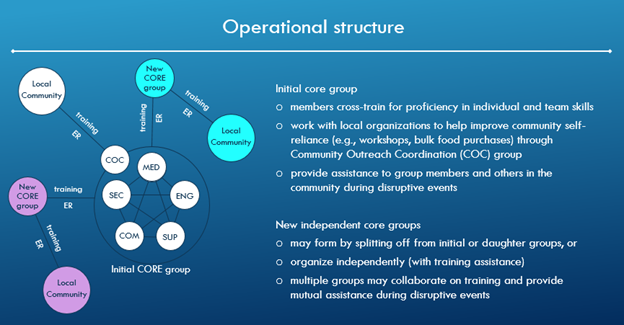
Background
The US and world economies are extremely complex systems
that are highly dependent on distribution systems for energy, food, raw
materials and manufactured goods, which are in turn dependent on a complex web
of electronic communication systems, computer networks, logistics systems, and
transportation networks.
Accidental or intentional breakdowns in any one of thousands
of components can leave millions of people instantly without power,
communications, or water. Food stocks in stores can disappear within hours to
days if not resupplied. Food in most people’s fridge will spoil within a few
days and their pantry’s will be empty soon afterwards. Few people have stores
of food and means to live without public water and power.
If a more extensive breakdowns occurred (e.g., EMP,
thermonuclear, or serious cyberattack), DoD projections are that >90% of the
US population could die within a few months. If recent mass shootings and
natural disasters are any guide, most people could die while trying frantically
to ‘tweet’ their friends.
Folks in rural areas have more options for survival, but
only if they take responsibility for themselves and their family and have
pre-established means of collaboration within their communities. Unlike the
Depression in the 1930s when most of the population lived on farms or had close
relatives who did, and when farmers were actually relatively self-sufficient,
most farmers today are essentially heavy equipment operators who get their
groceries from supermarkets like everyone else.
The govt will likely be too busy saving its own skin to
worry much about everyone else, especially those in remote and economically
insignificant areas. Even if a few people can avoid immediate death in a FEMA
camp, depending on government handouts to survive is not a good game plan.
People are social animals that need communities to survive –
physically and emotionally, especially when conditions are difficult.
Getting as many people in your neighborhood—and as far
beyond as possible— capable of surviving natural or manmade disasters and helping
others to the extent possible, is the most practical solution.
We believe there isa moral and ethical duty to do this. But
even if you are concerned for yourself and family only, every person who is
prepared is one less person who may resort to stealing or killing to feed
himself and his family. So, self-interest and moral obligation are in
alignment.
Mission and Organization
The mission of the Community Self Reliance group is to
improve individual, family and community resilience to disruptive events by
encouraging, teaching and practicing self-reliance skills and grass-roots
organization, by establishing and training core groups within local communities
that can provide mutual support during disruptive events and assist others in
the community to the extent practicable, and to train new core groups to
establish a loosely affiliated mutual assistance network.
All members would ideally have at least minimal knowledge and
experience in five skill areas and a higher level of expertise in at least one
specialization. The five skill areas are:
We regard the following skill areas as the foundational
pillars of community self-reliance:
MED – Health/medical: ability to provide medical care when needed;
preventing illness; herbal and other methods
SUP – Food production/storage: gardening, animal
husbandry/butchering, canning, freezing, smoking/drying, fermentation, other
supplies
ENG – Engineering/construction: water, power, shelter, waste
handling, construction/repairs, fire fighting
COM – Communications/logistics: routine and emergency comms,
supply logistics
SEC – Security/intel: neighborhood protection, small unit
tactics, self-defense skills, intel collection and analysis (normal and
grid-down)
Currently, we hold monthly general meetings that are open to
anyone in the county or beyond interested in learning basic self-reliance
skills, to be an asset rather than a liability to their family and neighbors in
the event of a natural or other disaster.
For those who wish to go to the next level of self-reliance,
we believe the ideal core community self-reliance organizational unit to be a
group families within a few miles of each other with at least 12 individuals
fit enough to move off-road by foot if required with up to 50 pounds of gear to
handle security and other tasks requiring physical fitness. The remaining group
members may serve as “auxiliaries” for less taxing physically demanding tasks
as conditions require. All members should be able to provide assistance to
others in the group within their skill sets and physical limitations, as well
as to assist others in the community to the extent resources permit.
If you cannot find enough potential members within a few
miles, you may decide to organize a core group with a larger geographic extent
or work with a more distant established group until enough people can be found
nearby.
In any case, organizational duties should be agreed upon in
advance. While some sort of democratic order may be appropriate in
non-emergency circumstances, in a serious emergency, thousands of years of
human history show that a military-type order of authority is needed in austere
conditions when debates over decisions could lead to early death. Relevant
chain-of-command and conditions in which strict adherence will be required,
must be clearly defined in advance.
